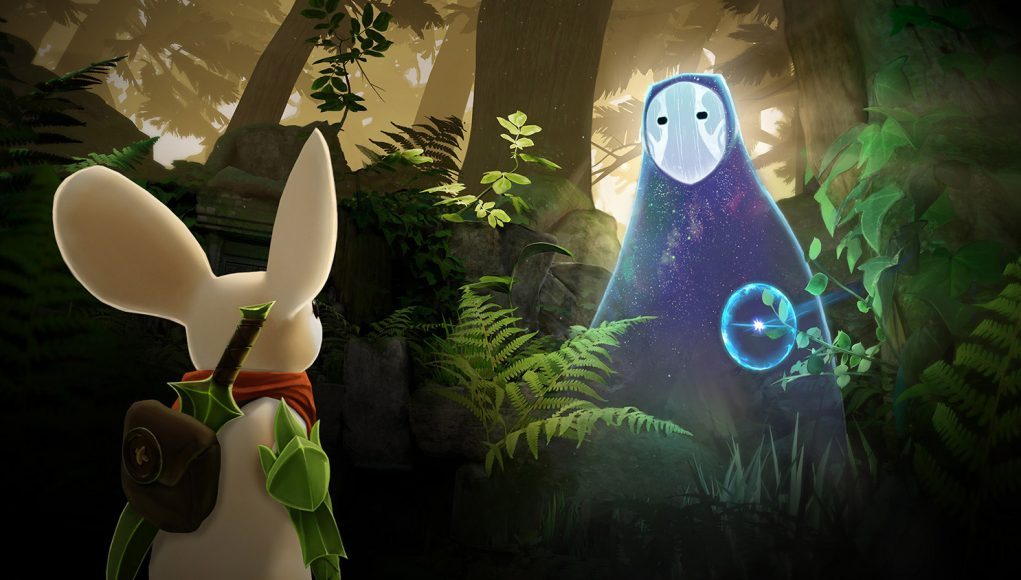Moss, the promising puzzle platformer from indie studio Polyarc, has finally arrived on PlayStation VR. You’ll guide Quill, an undeniably adorable mouse, on the start of what could become a grand adventure.
Moss Details:
Developer: Polyarc
Available On: PlayStation VR [Amazon] (PlayStation Store)
Reviewed On: PS4 Pro
Release Date: February 27th, 2018
Gameplay
Moss is a third-person platformer, played with the PS4 controller, which mixes in some VR-specific gameplay in the form of reaching out and controlling some parts of the game world (using the motion-tracked controller as if it was your hand), and being able to look around the world (with the headset’s tracking) to get a better angle on hard to see paths and secrets.
The platforming gameplay is basic: you’ll be guiding Quill as she runs, jumps, and shimmies along and over ledges. There’s also some combat thrown into the mix, a very light weight smattering of attacking and dodging. Between the jumping and the slashing mechanics, there isn’t a terrible amount of depth, but to its credit, the mechanics are all quite tight.
However, this is the kind of game that only lets you jump on platforms or grab onto ledges that it says you can; sometimes you might want to grab onto what looks like an obviously useful ledge, only to find that it doesn’t have the tell-tale signs of ‘a ledge you can grab onto’, which can be a little annoying as it stifles any chance of platforming creativity. But maybe I’m just still mad that, 15 years later, Prince of Persia: The Sands of Time series somehow still hasn’t been surpassed as the pinnacle of freestyle platforming and combat. But that’s a rant for another time.
At the beginning of the game you’ll be introduced to Quill. I say “introduced” because you as the player act as an entity in the world, a helpful spirit that characters refer to as “The Reader,” which makes sense within the game’s expository context, where you ‘read’ the tale of Quill from a book. In fact, during the game’s story moments, you’ll appear back in the library and flip the pages as short story segments unfold. At the end of each story segment, you’ll flip over a page and get sucked back into Quill’s world.
The whole game is contained within this idea of a book, chapters, and pages. From your static third-person perspective, you’ll move Quill through an area, generally exiting on the right, and then things will fade to black (with the sound of a page turning) before a new scene loads and you see Quill approach from the left.
Each scene is an artfully constructed diorama, with great composition and lightning, especially in the earlier parts of the game. You can expect to have Quill hop across platforms, fight some baddies, and occasionally require your help for solving interactive puzzles, which involve you reaching into the game world (using the tracked controller) to lend a helping hand.
Objects that you as the player can interact with are marked with a unique style to help you understand that they’ll be useful for puzzle solving. You might lift up a platform so that Quill can make a jump, move a statue to somewhere important, or spin a spiral staircase into the right position to get her where she needs to go. The puzzle difficulty felt like it hit a nice sweet spot for this kind of game, there was some occasional head scratching, but nothing that became frustrating.
This is all well and fun, and pretty unique as far as traditional platformers go. It’s well executed, but I couldn’t help but feel like my interactions with the game world (as the player), and with Quill, never quite ascended into something truly special. Beyond slowly moving some things, touching Quill to heal her after she gets hurt, and grabbing enemies to mind control them, there’s not all that much meaningful direct interaction between the player and the game world. I think one issue being that I was able to reach into the world, but the world never really reached back at me in a way that truly mattered.
That missing something was also prevalent in Moss’ combat and platforming. There’s only three enemy types in the game, and not enough combat variety between them. There are moments where you’ll do some platforming and fighting, but I never felt they achieved a graceful rhythm together.
Where the game makes up a lot of ground is with its excellent art & sound direction and heaps of polish. Moss is undoubtedly one of PSVR’s best looking games, and Quill herself is impeccably animated and terribly cute. Great attention to detail can be seen throughout, but just to point out one bit: if Quill is standing on a spinning platform, you can see her body (and especially her big ears) physically react to the spinning force. You can also reach out and give her a nice head scratch, which is adorable.
As far as story goes, Moss begins formulating an interesting world before your eyes. There’s a lot to soak in as you go throughout the world; you aren’t a giant, Quill is just small, and her adventure is actually set in a regular sized world which happens to have lots of little mouse-sized structures. So you can expect to see regular sized things like trees, and more. You’ll be introduced to a different spirit who helps Quill along her quest, as well as Quill’s uncle who is said to have ‘seen some shit’ back in his day. The world that Moss starts to construct seems very interesting, but all ends up feeling underdeveloped by the end of the game… like a half-written book.
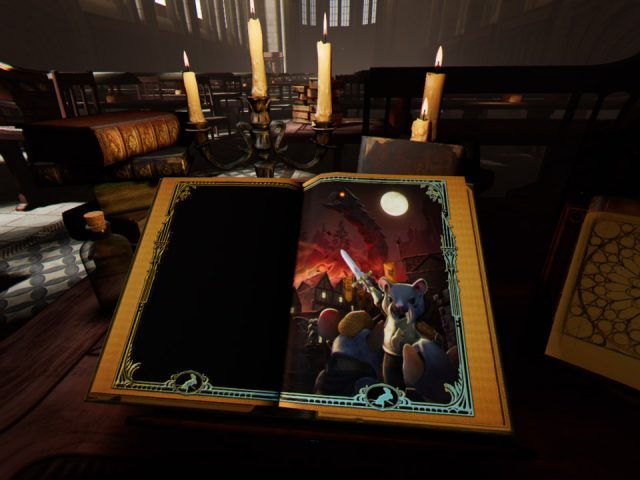
See… the end of the game, which took me only about three hours to complete (even with finding the vast majority of bonus collectibles), drops big hints that Moss is just the first book of many adventures that you’ll one day go on with Quill. But rather than an entire book, Moss left me with the feeling of being just a chapter or two. The climax came too quickly, and ended up not feeling like much like a climax (neither story-wise nor gameplay-wise). Instead of a proper denouement, you’re hit with a cliff hanger and lots of dangling threads that seemed like they were going somewhere but veered off page without ever being mentioned again.
It seems very much like Polyarc wants to bring regular episodic content to Moss in the future. At $30, perhaps this could have been anticipated, though I think it might have been smart for the studio to make this explicitly clear to players by calling the game something like ‘Moss: Chapter I’.
Immersion
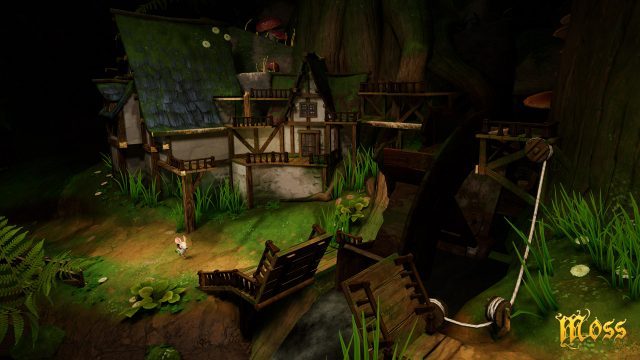
Moss is a beautiful game. Polyarc’s skill with Unreal Engine 4 is clear, and it seems they smartly constructed the game in a way that allowed them to spend the most time on the parts that you’ll spend the most time with (like Quill and scenes she’ll traverse through). Specifically, with the key story elements being relegated to short, flat sequences, Polyarc was presumably able to limit the amount of time spent animating story sequences, and instead give Quill herself an extra helping of polish.
Indeed, her animations are excellent across the board, and little touches like being able to cut down blades of grass and chop sticks were welcomed. Quill occasionally recognizes you as the player, like giving you some encouragement when solving a touch puzzle, or squeaking to get your attention to give you a hint, which is both adorable and welcomed interaction that adds a hint of depth between you and her.
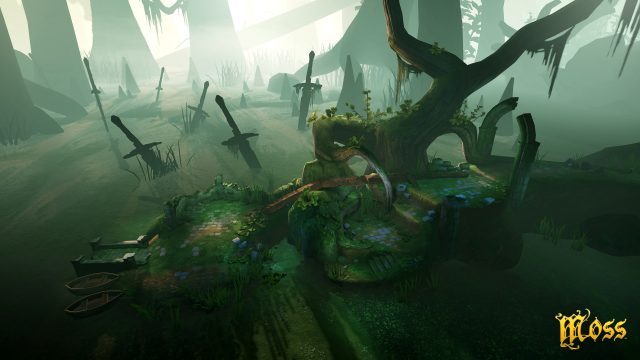
The game’s environments are easy to get lost in. Polyarc’s choice to center the game around a tiny mouse means they can make very effectively make artistic use of scale. Indeed, you’ll see the tinpuy villages and buildings of Quill’s scale set against of background of a normal sized world.
It’s neat looking for tiny details (like where Quill might be able to jump up and grab a ledge), and then take a step back and realize that there’s a huge tree towering over your head. Elements of the life-sized world are scattered throughout, and sometimes feel foreboding, but unfortunately they never end up really interacting with your gameplay.
Especially earlier in the game, each scene is a beautiful little diorama, and it’s a shame that you don’t spend more time in them, since it’s clear how much care went into them. For instance there’s an adorable and quaint village that you’ll pass through, and even though it begs for further inspection and exploration, you go on your merry way, never to see it again. I wanted to know and feel more about the world of Moss than I was given.
Comfort
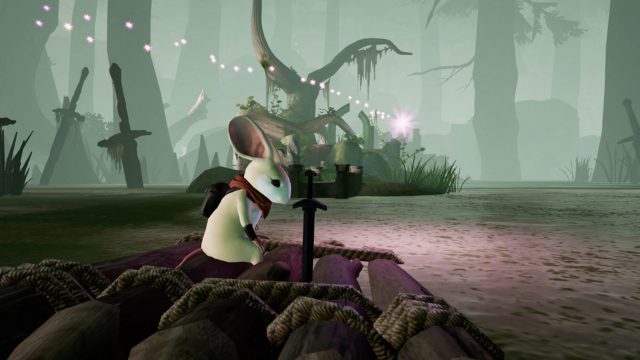
I played the game seated throughout.; from start to finish, Moss’ fixed perspective makes for a perfectly comfortable game (jitter from PSVR’s tracking notwithstanding). I was easily able to play the game in large chunks without a hint any nausea.
Using the motion-tracked PS4 controller as a way to reach into the world is a neat idea and generally executed well, though sometimes the tracking got jumpy in the heat of an important moment (like trying to heal Quill), which could be a little frustrating.
Ideally you have absolutely nothing between you and your PS Camera, because a coffee table (and objects on it) could block your tracking. The glass surface of my coffee cable seemed to cause the tracking a bit of trouble, and there are moments where if I hadn’t cleared it completely, I certainly would have knocked over any latent beers and had a fun mess to clean up. Mark my words, this will happen to someone (if not many people).

